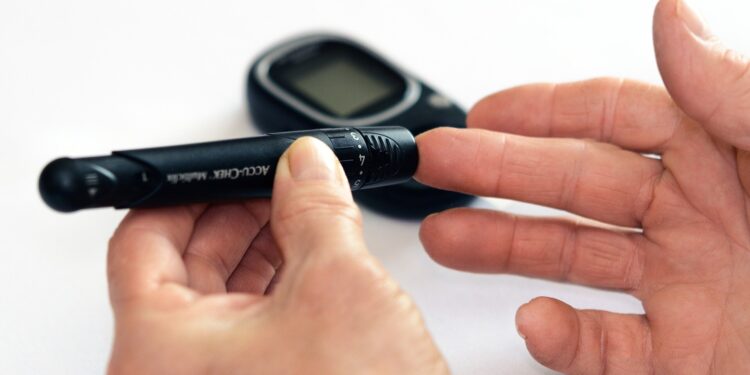Credit: CC0 Public domain
Sinai Health researchers have discovered vital information about the relationship between insulin levels after eating and long-term heart and metabolic health. Research overturns the idea that an insulin surge from food intake is a bad thing.
On the contrary, it could be an indicator of good health in the future.
Led by Dr. Ravi Retnakaran, a clinician-scientist at the Lunenfeld-Tanenbaum Research Institute, part of Sinai Health, the study aimed to explore the impact of post-meal insulin levels on cardiometabolic health. While previous research has yielded conflicting results, suggesting both harmful and beneficial effects, this new study aimed to provide a clearer picture over an extended period of time.
The team reported its findings in eMedicineClinical.
Normally, insulin levels increase after eating to help manage blood sugar levels. However, the question is whether a rapid surge in insulin after a meal could lead to poor health. Some believe that the insulin surge, especially after eating carbohydrates, promotes weight gain and contributes to insulin resistance. This happens when the body’s cells don’t respond well to insulin, making it harder to control blood sugar and increasing the risk of type 2 diabetes.
“Some people have suggested that these insulin spikes may have deleterious effects by promoting weight gain,” said Dr. Retnakaran, also an endocrinologist at the Leadership Sinai Center for Diabetes at Mount Sinai Hospital, where he serves as the Boehringer Chair. Ingelheim. in the preservation, function and regeneration of beta cells. He is also a professor at the Temerty Faculty of Medicine at the University of Toronto.
“Sometimes I see patients in the clinic who have adopted this idea, maybe from the Internet or from what they read, that they can’t see their insulin levels being too high,” a- he declared.
The science is simply not conclusive enough to support this notion. Most studies on this topic were conducted over a short period of time or were based on isolated insulin measurements that are inadequate and can be misleading, Dr. Retnakaran said.
His team sought to address this problem by examining the cardiometabolic implications of the long-term insulin response, and in a way that accounts for baseline blood sugar levels. This last point is essential because each person has an individual insulin response which varies depending on the amount of sugar in the blood.
The study followed new mothers because insulin resistance that occurs during pregnancy helps determine their future risk of type 2 diabetes. A total of 306 participants were recruited during pregnancy, between 2003 and 2014, and underwent comprehensive cardiometabolic testing, including glucose challenge testing, one, three, and five years postpartum. The glucose challenge test measures glucose and insulin levels at different times after a person drinks a sugary drink containing 75 grams of glucose and after a period of fasting.
Although commonly used in medical practice, interpretation of insulin levels from the test can be misleading if baseline blood glucose is not taken into account. “It’s not just about insulin levels, it’s about understanding them in relation to glucose,” Dr. Retnakaran said, pointing out that this is where many past interpretations have failed. A better measure is corrected insulin response (CIR), which takes into account baseline blood sugar levels and is slowly gaining importance in the field, he said.
The study revealed some surprising trends. As the corrected insulin response increased, there was a noticeable worsening in waist circumference, HDL (good cholesterol) levels, inflammation and insulin resistance, if not taken into account. take into account the accompanying factors. However, these seemingly negative trends were accompanied by improved beta cell function. Beta cells produce insulin, and their ability to do so is closely associated with diabetes risk: the better the beta cell function, the lower the risk.
“Our results do not support the carbohydrate-insulin model of obesity,” said Dr. Retnakaran. “We observed that a robust insulin-secretory response after challenge, when adjusted for glucose levels, is only associated with beneficial metabolic effects. Not only does a robust insulin-secretory response after challenge indicate not unfavorable cardiometabolic health, but rather it predicts favorable metabolic function in the years to come.
Some practitioners subscribe to the idea that higher insulin levels are a bad thing and sometimes recommend that patients limit their insulin fluctuations after eating. but it is not that simple
In the long term, higher corrected insulin response levels were associated with better beta cell function and lower glucose levels, without correlation with BMI, waist circumference, lipids, inflammation or insulin sensitivity or resistance. More importantly, women who had the highest CIR had a significantly reduced risk of developing prediabetes or diabetes in the future.
“This research challenges the idea that high insulin levels after meals are inherently bad and is an important step forward in our understanding of the complex roles insulin plays in regulating metabolism,” said Anne-Claude Gingras, director of LTRI and vice-president. research at Sinai Health.
Dr. Retnakaran hopes their findings will reshape the way healthcare professionals and the public view the role of insulin in metabolism and weight management.
“Some practitioners subscribe to the idea that higher insulin levels are a bad thing and sometimes make recommendations to patients to limit their post-meal insulin fluctuations. But it’s not that simple,” he said. he declared.
More information:
Future cardiometabolic implications of insulin hypersecretion in response to oral glucose, eMedicineClinical (2023). www.thelancet.com/journals/ecl… (23)00540-0/fulltext
Provided by the Lunenfeld-Tanenbaum Research Institute
Quote: New research challenges the idea that the post-meal insulin surge is a bad thing (December 13, 2023) retrieved December 14, 2023 from
This document is subject to copyright. Apart from fair use for private study or research purposes, no part may be reproduced without written permission. The content is provided for information only.



